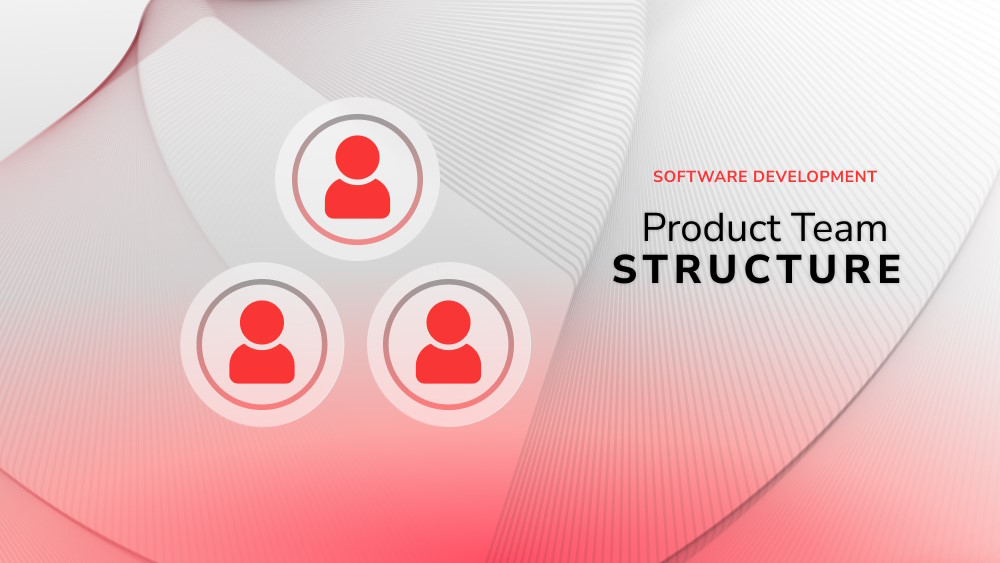4 Ways to Build Your Product Team Structure

Content Map
More chaptersScaling your product team can be a massive challenge in today’s fast-paced business world. As your organization grows, you will need to ensure that your product team structure can keep up with the demands of your ever-expanding customer base.
An effective, scalable structure is at the heart of any successful product team. In this article, Orient will provide you with essential information about a software product development team and how to structure such a team for delivering high-quality products and services to your customers. Whether you are just starting or looking to take your product team to the next level, let’s dive in!
What is A Product Team?

A product development team is a cross-functional group of professionals working together to develop products based on certain market needs. A fully functional product team may include individuals with diverse skill sets and backgrounds, such as product managers, designers, developers, quality assurance analysts, data analysts, marketing professionals, and sales representatives.
Because of the complexity of the product development process, product managers often break down the product team into small teams to make it easier to manage work and ensure that all product team members are on the same page. Smaller teams can also focus more effectively on specific tasks and business strategies without getting distracted by competing priorities or too many different voices.
Overall, the primary goal of a product team is to create a product that meets the needs and expectations of the target audience while staying within budget and on schedule. This involves closely working throughout the development process, from ideation and prototyping to software testing and launch.
What Is the Product Team Structure?
Product team structure refers to how a company or organization organizes its employees and resources to develop, design, and bring a product to market. The structure of the product development team can vary depending on the size, organizational structure of the business, and the complex nature of the product being developed.
However, no matter what form it is built in, what makes a successful cross-functional product team still lies in the elements of effective communication, close collaboration, timely efficiency, and adaptability due to changing market conditions or customer needs.
3 Core Roles Within Product Teams

Depending on how you structure your product team, each cross-functional team will have different key roles. Below are the key positions that any product management team needs.
Product Manager
Every project needs a leader. And the person who plays the leading role in a software development project in a company is called a product manager.
As the central point of contact between different teams and different stakeholders, the product manager is responsible for managing the day-to-day development of a specific product or product line while meeting target customers’ needs and achieving business goals. By working closely with the cross-functional teams and other teams like the marketing and sales team, the product leader ensures that all the product features are built to the best quality and provide maximum value to customer objectives.
The name of the product manager position can change depending on the nature of the business and how the company operates internally. So, you can easily come across a product manager with another name, such as product owner, product leader, or even chief product officer. While there may be some variation in how product managers in product teams are defined and implemented across different organizations, their core task is still product management.
Product Developer
How many developers do you need to assign to your product team? There is no accurate answer to this question because the number of developers in the product development team depends on many factors, especially the size and difficulty of the software products. However, a product management team can only survive and thrive with the presence of product developers.
To find ways to deal with engineer shortages in the current context and shorten the recruitment process, today’s companies often look to dedicated developers as a convenient and less expensive alternative but sometimes even achieve higher business efficiency than in-house developers.
By definition, software developers are team members responsible for the entire product development process, including coding and testing new product features and fixing bugs and issues. These engineers have extensive technical knowledge of popular programming languages and are up-to-date with the latest technologies.
Product developers work closely with the project managers and product designers to ensure that the product aligns with the overall product vision. They may also collaborate with multiple teams, such as quality assurance analysts, data analysts, and marketing and sales professionals, to deliver high-quality user experience.
Product Designer
Product designers represent the customer’s point of view. By focusing solely on creating user interfaces that are intuitive and seemingly appealing, they make software product to be more catching and easier to use.
Like the two key roles above, product designers in product teams must work closely with product managers to analyze market tastes and customer feedback, thereby producing designs that meet the target audience’s needs and aligns with the overall product vision.
How to Structure Your Product Team?
There are various ways a business can structure product teams. Here are some of the common ways to structure your product management team.

Structuring Based on Product Features
What Is Product-feature-based Structuring?
If your company is developing a software development product with more than one essential complex feature, you can consider building your product team with this approach.
To be more specific, structuring a product development team based on product features is the approach in which product teams are structured around particular product features or modules. The quantity of important product features corresponds with the number of small product teams. That is why every product squad has an organizational structure like a complete development team. Each team has full positions in different departments, such as product management, design, engineering, and quality assurance.
By structuring teams around product features, the company ensures that each team has deep knowledge and expertise in their specific area of the product. This approach can lead to faster and more efficient development, as each team can work independently, minimizing dependencies and delays.
However, this kind of product team structure can end up working competitively instead of supporting each other as inherently intended. The job of product leaders is to engage team members in feature teams to avoid miscommunication and create smooth cross-functional collaboration.
Example of Product-feature-based Structuring
For instance, consider a company that develops billing software. The app may have multiple features like payments, invoice creation, discount management, and settings. To manage each feature effectively, the company can organize product teams around each feature, including a payment team, invoice creation team, etc. Each team will be responsible for defining and prioritizing features, designing user interfaces, writing code, testing, and releasing updates related to their specific feature.
Structuring Based on Customer Persona or Customer Segment
What Is Customer-segment-based Structuring?
If your business’s product has a diverse customer base with varying preferences and wants to develop products that cater to the unique needs of each group, structuring your product team based on customer personas or customer segments is useful in this situation.
When structuring product teams based on customer persona or segment, the focus is on organizing teams around the needs of specific customer groups. By conducting market research and user research, this kind of team structure easily sees product teams group customers according to specific demographics or attributes. It thereby divides the product development team into subgroups corresponding to customer segments.
By structuring product teams around customer personas or segments, the product owners ensure that all cross-functional teams have a comprehensive understanding of their customer group’s needs and pain points, improving customer satisfaction and loyalty.
This approach can cause the whole product management team to lose direction and lack collaboration and internal links if the company has multiple products offered to one customer segment.
Example of Customer-segment-based Structuring
For instance, consider a company that develops an e-commerce platform. The platform may have a diverse customer base, including different age groups, genders, and geographical locations. To serve each group effectively, the company can organize product teams around each customer persona or segment, including a team for young adults, a team for women, a team for customers in a specific geographical location, and so on.
Structuring Based on the Customer Journey
What Is Customer-journey-based Structuring?
This is a form of structuring product development teams focusing on different stages of the customer journey – from initial awareness to final decision-making.
Similar to the customer-segment team structure, this approach leads to the development of targeted solutions that resonate with customers, improving the overall customer experience and satisfaction. Customer-journey-based structuring requires the company to assign a different product leader to given user stages, such as awareness, consideration, purchase, retention, and advocacy. By understanding customer consumption behavior, product managers direct the product development team to tailor features that lead customers down the funnel.
Because assessing customers’ consumption behavior based on the customer journey is very difficult and requires a lot of time and professional skills, structuring product teams around the customer journey can lead to a poor product experience.
Example of Customer-journey-based Structuring
Consider a company that develops a banking app. The app may have different features and capabilities that cater to customers at different stages of their journey. To serve each stage effectively, the company can organize product teams around each stage of the customer journey, including a team for awareness, a team for consideration, and a team for decision-making.
Structuring Based on Performance Metrics
What is Performance-metric-based Structuring?
If the product owner has prepared the business in advance with clear key performance indicators (KPIs), you can use performance metrics such as revenue, user engagement, or customer retention for your product team structures.
This approach is useful when the business wants to align the product development cycle with the overall business goals and ensure that the product decisions are data-driven. When structuring a project management team based on target metric values, each team is responsible for independently performing tasks and developing organization software products to keep track of business requirements and achieve metrics goals.
However, choosing performance-metric-based structuring makes you heavily dependent on KPIs. It would be great if you hit the KPI during your work. Conversely, if the KPI is not met, the operation of the product team and product development can be interrupted when one metric may flow into another.
Example of Performance-metric-based Structuring
For example, a company that develops a social media platform. The platform’s primary business goal is to increase user engagement, which can be measured by metrics such as likes, shares, and comments. To achieve this goal, the company can organize product teams around user engagement, including a team for content creation, a team for user experience design, and a team for engagement analytics.
There Is No Best Organizational Structure!

No “best” organizational structure exists because every business is unique, and what works for one company may not work for another. Different organizational structures have different advantages and disadvantages, and the optimal structure depends on various factors such as business goals, culture, size, industry, and customers.
It is the job of product owners to understand the very needs and nature of the business, understand the needs of customers and the tech market landscape in time to determine the optimal structure that promotes productivity, innovation, and growth.
Orient has a piece of advice. Regardless of the structure chosen, you can apply Agile methodologies to rapid response to change and align with the overall product vision to win the customers. It is time for you to take action. Good luck.







